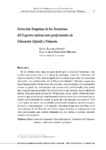Mostrar o rexistro simple do ítem
Detección temprana de los transtornos del espectro autista entre profesionales de Educación Infantil y Primaria
| dc.contributor.author | Álvarez Otero, Silvia | es_ES |
| dc.contributor.author | Fernández Méndez, Juan Carlos | es_ES |
| dc.date.accessioned | 2014-10-02T12:42:53Z | |
| dc.date.available | 2014-10-02T12:42:53Z | |
| dc.date.issued | 2014 | es_ES |
| dc.identifier.citation | Encuentros sobre psicología, comunicación y lenguaje, 2014: 79-96. ISBN: 978-84-9749-585-1 | es_ES |
| dc.identifier.isbn | 978-84-9749-585-1 | es_ES |
| dc.identifier.uri | http://hdl.handle.net/2183/13542 | |
| dc.description.abstract | [Resumen] En los últimos años surge un gran interés por la A tención Temprana y por la detección precoz (de 0 a 6 años) de patologías como los Trastornos del Espectro A utista (TEA), dada la significativa incidencia que tiene en el posterior desarrollo. L os profesionales de la Educación Infantil y Primaria juegan una baza fundamental en dicha detección; por ello, con este trabajo se ha pretendido evaluar el grado de conocimiento que poseen estos profesionales para emitir una sospecha ante un posible TEA a través de su conocimiento de las señales de alarma. Han participado un total de 108 personas, de las cuales 34 eran docentes en activo que tuvieron que cumplimentar de forma online un cuestionario que se diseñó con la finalidad de valorar su grado de conocimiento acerca de los TEA y los signos de alerta. L os resultados pusieron de manifiesto que los maestros en activo, contrariamente a lo esperado, presentaron una tasa más baja en el conocimiento de los TEA así como de los signos de alerta, en comparación con otros participantes que estaban trabajando en otro ámbito o estaban cursando estudios universitarios. | es_ES |
| dc.description.abstract | [Abstract] In the last years a great interest arises for the Early A ttention and for the precocious detection (from 0 to 6 years) of pathologies as the A utistic Spectrum Disorders (ASD), given the significant incident that has in the later development. The professionals of the kindergarten and primary education play a fundamental advantage in the above mentioned detection; for it, with this work one has tried to evaluate the degree of knowledge that these professionals possess to issue a suspicion before one possible TEA across his knowledge of the red flags. They have informed a total of 108 persons, of which 34 were educational in assets that they had to complete of form online a questionnaire that was designed by the purpose of valuing his degree of knowledge it brings over of the TEA and the red flags. Involving a total of 108 people, of which 34 were active teachers who had to fill in a questionnaire online so that was designed in order to assess their level of knowledge about A SD and the warning signs. The results showed that active teachers, contrary to expectations, had a lower rate on knowledge of A SD as well as warning signs, compared with other participants who were working in another field or were studying university. | es_ES |
| dc.language.iso | spa | es_ES |
| dc.publisher | Universidade da Coruña | es_ES |
| dc.subject | Atención temprana | es_ES |
| dc.subject | Detección precoz | es_ES |
| dc.subject | Trastornos del espectro autista | es_ES |
| dc.subject | Educación infantil y primaria | es_ES |
| dc.subject | Early warning | es_ES |
| dc.subject | Early detection | es_ES |
| dc.subject | Autism spectrum disorders (asd) | es_ES |
| dc.subject | Kindergarten and primary education | es_ES |
| dc.title | Detección temprana de los transtornos del espectro autista entre profesionales de Educación Infantil y Primaria | es_ES |
| dc.type | info:eu-repo/semantics/conferenceObject | es_ES |
| dc.rights.access | info:eu-repo/semantics/openAccess | es_ES |






